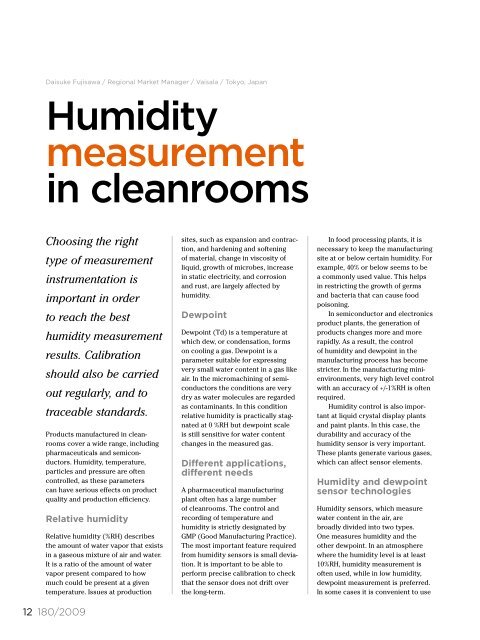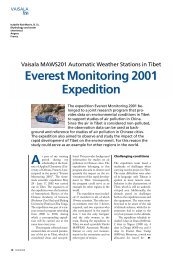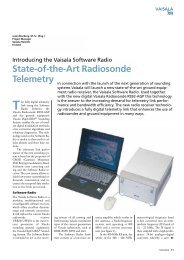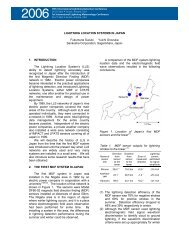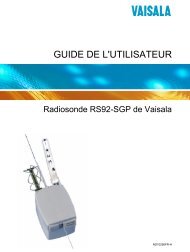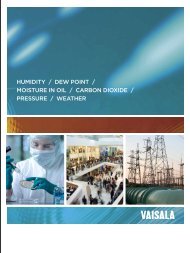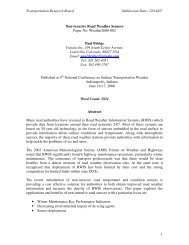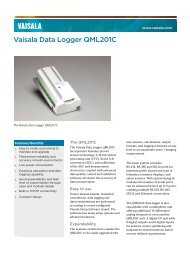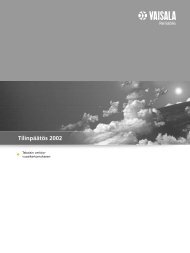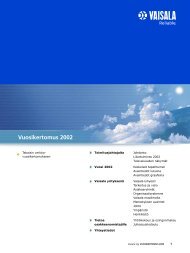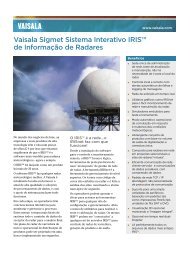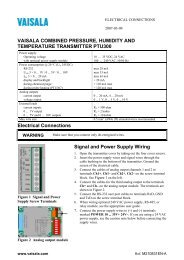Vaisala News 180 - Full Magazine
Vaisala News 180 - Full Magazine
Vaisala News 180 - Full Magazine
Create successful ePaper yourself
Turn your PDF publications into a flip-book with our unique Google optimized e-Paper software.
Daisuke Fujisawa / Regional Market Manager / <strong>Vaisala</strong> / Tokyo, Japan<br />
Humidity<br />
measurement<br />
in cleanrooms<br />
Choosing the right<br />
type of measurement<br />
instrumentation is<br />
important in order<br />
to reach the best<br />
humidity measurement<br />
results. Calibration<br />
should also be carried<br />
out regularly, and to<br />
traceable standards.<br />
Products manufactured in cleanrooms<br />
cover a wide range, including<br />
pharmaceuticals and semiconductors.<br />
Humidity, temperature,<br />
particles and pressure are often<br />
controlled, as these parameters<br />
can have serious effects on product<br />
quality and production efficiency.<br />
Relative humidity<br />
Relative humidity (%RH) describes<br />
the amount of water vapor that exists<br />
in a gaseous mixture of air and water.<br />
It is a ratio of the amount of water<br />
vapor present compared to how<br />
much could be present at a given<br />
temperature. Issues at production<br />
12 <strong>180</strong>/2009<br />
sites, such as expansion and contraction,<br />
and hardening and softening<br />
of material, change in viscosity of<br />
liquid, growth of microbes, increase<br />
in static electricity, and corrosion<br />
and rust, are largely affected by<br />
humidity.<br />
Dewpoint<br />
Dewpoint (Td) is a temperature at<br />
which dew, or condensation, forms<br />
on cooling a gas. Dewpoint is a<br />
parameter suitable for expressing<br />
very small water content in a gas like<br />
air. In the micromachining of semiconductors<br />
the conditions are very<br />
dry as water molecules are regarded<br />
as contaminants. In this condition<br />
relative humidity is practically stagnated<br />
at 0 %RH but dewpoint scale<br />
is still sensitive for water content<br />
changes in the measured gas.<br />
Different applications,<br />
different needs<br />
A pharmaceutical manufacturing<br />
plant often has a large number<br />
of cleanrooms. The control and<br />
recording of temperature and<br />
humidity is strictly designated by<br />
GMP (Good Manufacturing Practice).<br />
The most important feature required<br />
from humidity sensors is small deviation.<br />
It is important to be able to<br />
perform precise calibration to check<br />
that the sensor does not drift over<br />
the long-term.<br />
In food processing plants, it is<br />
necessary to keep the manufacturing<br />
site at or below certain humidity. For<br />
example, 40% or below seems to be<br />
a commonly used value. This helps<br />
in restricting the growth of germs<br />
and bacteria that can cause food<br />
poisoning.<br />
In semiconductor and electronics<br />
product plants, the generation of<br />
products changes more and more<br />
rapidly. As a result, the control<br />
of humidity and dewpoint in the<br />
manufacturing process has become<br />
stricter. In the manufacturing minienvironments,<br />
very high level control<br />
with an accuracy of +/-1%RH is often<br />
required.<br />
Humidity control is also important<br />
at liquid crystal display plants<br />
and paint plants. In this case, the<br />
durability and accuracy of the<br />
humidity sensor is very important.<br />
These plants generate various gases,<br />
which can affect sensor elements.<br />
Humidity and dewpoint<br />
sensor technologies<br />
Humidity sensors, which measure<br />
water content in the air, are<br />
broadly divided into two types.<br />
One measures humidity and the<br />
other dewpoint. In an atmosphere<br />
where the humidity level is at least<br />
10%RH, humidity measurement is<br />
often used, while in low humidity,<br />
dewpoint measurement is preferred.<br />
In some cases it is convenient to use


